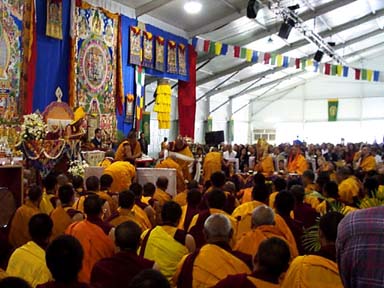GETTING TO KNOW US
-About the
TCC
-Thubten J. Norbu
-Our
mission
-Getting
Involved
-Gift
Shop
-Map
to TCC
-Pets
at the TCC
THE TCC GROUNDS
-Jangchub Chorten
-Kalachakra
Stupa
-Chamtse
Ling
-Retreat Cottages
-Grounds
stroll
EVENTS -PAST & FUTURE
-Event
Schedule
-Kalachakra
1999
-HHDL's
1996 Visit
-Medicine Buddha
Mandala
-Dorgyka Fire
Puja
-Event
Scrapbooks
TEACHINGS & SPEECHES
-Norbu's
1996 Speech to HHDL
-HHDL'S 1996 Teaching
-Aspirational
Bodichitta 1996
-Heart Sutra
3655 Snoddy Road
P.O. Box 2581
Bloomington, IN 47402
Fax: 812-335-9054
tcc@tibetancc.com


| page 1 | page 2 | page 3 | page 4 | page 5 |
- page 4 -
Overview of Shantideva's text by H.H. The Dalai Lama There are ten chapters to "A Guide to the Bodhisattva's Way of Life." We are studying the eighth chapter entitled ÔMeditation.Õ The first three have to do with cultivation of Bodhicitta. The second three assure that Bodhicitta doesn't decline. The final chapters are meant to safeguard that Bodhicitta doesn't decline. Therefore, they can be summarized in a three-sentence prayer: May the precious mind of enlightenment be generated. May those generated not decline. May they be enhanced higher and higher.
Brief commentary by HHDL on the verses of Bodhisattva's Way of Life No other person can initiate one's inner transformation. It is a solitary and gradual process, and we have an inborn tendency to procrastinate! Avoid distractions in meditation. Avoid attachment to people and things. Reflect on the fact that friends and family ultimately can't help you much -- at death we are alone. Resources and power also can't help you and they may even obstruct practice. Only meditative concentration conquers suffering. There is a need for serious commitment. Dharma practice in an easy life amounts to little. A true practitioner is someone like Milarepa -- total abandonment, solitude and equipoise.
A traveler won't invest much in each individual place. Our body too is temporary -- we shouldn't obsess with maintenance, glorification, or sustenance of it. We can understand the words self and others at the level of designation. Although an enlightened person may use the same words, they mean something different due to the experience of emptiness. This person will perceive the world differently, with a lesser degree of projection and lesser potential for extreme attachment.
Taking refuge and the Bodhisattva vows HHDL. We should cultivate a powerful sentiment of altruism by taking refuge in the Buddha, Dharma, and Sangha. If there are people here who are not Buddhists, they can substitute whatever refuge they'd like for the three jewels. The powerful state of altruism should be sustained and cultivated. Try to read the refuge prayer on a daily basis: With a wish to free all beings I shall always go for refuge to the Buddha, Dharma and Sangha until I reach full enlightenment. Enthused by wisdom and compassion, today in the Buddha's presence -- I generate the mind for full awakening for the benefit of all sentient beings. As long as space remains, as long as sentient beings remain, until then, may I too remain, and dispel the miseries of the world. For the Bodhisattva vows, do not imagine that you have taken them unless you feel you can commit to them. The key precept to remember is not to be dominated by self-cherishing but to have a sense of concern and care for others. A public ceremony doesn't bring people into and out of Buddhism -- this depends on whether you yourself take the Buddha, Dharma, and Sangha to be ultimate sources of refuge. It is possible to have an equal degree of faith in Buddhism and Christianity at the same time, and this isn't a question of being half Buddhist and half Christian. However, eventually one must choose only one philosophical path, because at this level the faiths differ.
Questions from the audience
1. How can we best be an example of change for those who suffer?
HHDL: It is possible for a person to change and being about change in others by serving them. Altruism is its own example. Buddhists sometimes neglect the action of Bodhicitta. During the past thirty years, in Nepal, there has been construction of many opulent temples and monasteries but no schools and hospitals. We should learn from Christianity in this area.
2. Are fainting and deep sleep our enemies due to lack of consciousness?
HHDL: No. Anuttara yoga tantras outline different levels of concentration and consciousness, and from them we learn that the subtlest level of consciousness is always present.
3. How can we help others without becoming swallowed up in their misery?
HHDL: Shantideva asks, since we have our own suffering, why must we take on others' suffering? His answer is that we must recognize the highest state as a combination between helping ourselves and helping others. Also, our own suffering descends upon us, and we can't help it, whereas the pain of sharing others' suffering is voluntarily accepted and therefore builds strength and courage.
4. Since we have no proof of reincarnation, what parts of Buddhism would remain valid if reincarnation were not true?
HHDL: Whether or not something is ÔproofÕ depends on the person. There are three levels of phenomena: evident phenomena, obscure phenomena, and very obscure phenomena. People can usually reach consensus on evident phenomena, but the other two rely upon rational thought processes and there is no consensus about these. Reincarnation can be substantiated by phenomena like past life memories. But it cannot be easily proven or disproven. There is a difference between not finding something and finding its absence. Science can prove the existence of something, but often can't negate. There are two categories of things in the world: those science can study and those which it cannot. For example, Kalachakra's cosmology can be studied, and science actually contradicts some of the historical aspects of the tantra. We must read these parts metaphorically, since this is a multi-layered tantra.
5. Is there free will in the karmic system?
HHDL: There is a system of twelve links of dependent origination. In order for karmic acts to come to fruition there must be other factors and conditions present. Even arhats have karmic seeds, but they are impotent. There are multiple karmic potentialities in each of us; at death, one may activate the better karmic seeds leading to better rebirth. The conditions are in our control. Imagine you are taking a flight -- you've booked a ticket, packed your bags, called a taxi, but still conditions may prevent your arriving on the plane. You may also still choose not to fly. Once the plane is in the air, however, you are in fate's hands. Karmic fruition works the same way. Karma is only created out of free will in the first place.
6. Is it wrong to suppress emotions?
HHDL: Sometimes anger and other emotions come out as a result of past experience and should be expressed. But if we have no restraint, we may become prone to that emotion. The best thing to do is simply to recognize the destructive nature of that emotion, and to recall the experience of compassion. We may also divert our attention through breathing, etc. The response depends on the particular person.
7. My husband is a Buddhist and he wants to go off into the woods to live in solitude. I am wondering if it is better to do this or to consider his wife's feelings, since she doesn't want him to go?
HHDL: Maybe if a person is so advanced he should seek solitude, but usually it is better to be careful of others' feelings, because in the woods nothing may happen! It's important to try to be a constructive member of society, to become engaged with society.
8. How can we perform acts of true kindness if even with the best intentions may lead us the wrong way?
HHDL: Ultimately, the purity of the motive determines whether an act is positive or negative, even though the act may be of no benefit.
9. What is the relationship between attachment and family? How should we form close relationships?
HHDL: The key to close relationships is firm respect, not just attraction. Attractions should be based on respect and appreciation for the other person in his own right.
10. Since supposedly only a man can become a Buddha, why is it that I see so few men here taking advantage of their opportunity?
HHDL: It is generally thought that women are more susceptible to violence, etc. I think that rebirth as a man is only more fortunate in this sense. The societal bias against women is historical, and in the Buddhist texts although it is found in the Vinaya it is not found in the highest yoga tantras, like Kalachakra. Also, Shantideva's text was traditionally taught in a monastery, not in public like this. Therefore it contains a portion on the defilements of womens' bodies intended to help celibacy. It could be turned around and used in a nunnery. The mentions in Buddhist texts of male births being better should be taken in context.
A concluding note: I congratulate those who came only for the teachings -- for these are more important than the initiation, more basic. Kalachakra is good because it's popular, it attracts people -- but I really want to spend time on preliminaries! I don't see how it can do any good to just attend an empowerment alone, unless you have a very firm basis in the preliminaries.
Days Seven through Eleven: The initiation After the teachings ended, only one day of offering dances and rituals separated the audience from the initiation itself. The sand mandala had been finished, and ceremoniously shrouded with curtains and banners and vases filled with foliage. Glass windows had been placed around its four sides. Hollywood stars -- notably Richard Gere and reportedly an incognito Harrison Ford -- had taken their seats alongside a rapidly growing number of Tibetans from all over the world. On the seventh day, after a final long morning of sadhana practice by the Lamas, dancers costumed to appear as the twelve offering goddesses emerged, and much of the seventh day was occupied by their performance. By the eighth day the tent was nearly full, and everyone was eager to delve into the rituals of the Kalachakra initiation itself.
| page 1 | page 2 | page 3 | page 4 | page 5 |
| back to kalachakra 1999 index | back to main sitemap |
